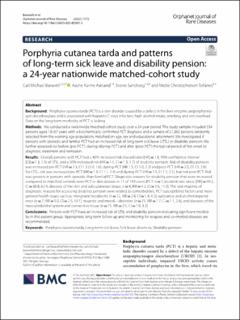| dc.description.abstract | Background
Porphyria cutanea tarda (PCT) is a skin disorder caused by a defect in the liver enzyme uroporphyrinogen decarboxylase and is associated with hepatitis C virus infection, high alcohol intake, smoking and iron overload. Data on the long-term morbidity of PCT is lacking.
Methods
We conducted a nationwide matched cohort study over a 24-year period. The study sample included 534 persons aged 18–67 years with a biochemically confirmed PCT diagnosis and a sample of 21,360 persons randomly selected from the working age population, matched on age, sex and educational attainment. We investigated if persons with sporadic and familial PCT had an increased risk of long-term sick leave (LTSL) or disability pension. We further assessed risk before (pre-PCT), during (during-PCT) and after (post-PCT) the typical period of first onset to diagnosis, treatment and remission.
Results
Overall, persons with PCT had a 40% increased risk (hazard ratio [HR] = 1.4, 95% confidence interval [CI] = 1.3, 1.5) of LTSL and a 50% increased risk (HR = 1.5, CI = 1.3, 1.7) of disability pension. Risk of disability pension was increased pre-PCT (HR = 1.3, CI 1.3 (1.0, 1.6), during-PCT (HR 1.5, CI 1.0, 2.2) and post-PCT (HR = 2.0, CI 1.5, 2.6). For LTSL, risk was increased pre-PCT (HR = 1.3, CI 1.1, 1.4) and during-PCT (HR = 1.5, CI 1.1, 2.1), but not post-PCT. Risk was greatest in persons with sporadic than familial PCT. Diagnostic reasons for disability pension that were increased compared to matched controls were PCT or skin disease in 11 of 199 cases (PCT: n = 7, incident rate ratios [IRR] = 49.2, CI = 38.8, 62.4; diseases of the skin and subcutaneous tissue, n = 4, IRR = 4.2, CI = 1.6, 11.0). The vast majority of diagnostic reasons for accessing disability pension were related to comorbidities, PCT susceptibility factors and more general health issues such as: malignant neoplasms (n = 12, IRR = 2.4, CI = 1.4, 4.2), substance and alcohol dependence (n = 7, IRR = 5.0, CI = 2.5, 10.1), neurotic and mood—disorders (n = 21, IRR = 1.7, CI = 1.1, 2.6), and diseases of the musculoskeletal system and connective tissue (n = 71, IRR = 2.5, CI = 1.9, 3.2).
Conclusions
Persons with PCT have an increased risk of LTSL and disability pension indicating significant morbidity in this patient group. Appropriate long-term follow-up and monitoring for relapses and co-morbid diseases are recommended. | en_US |

